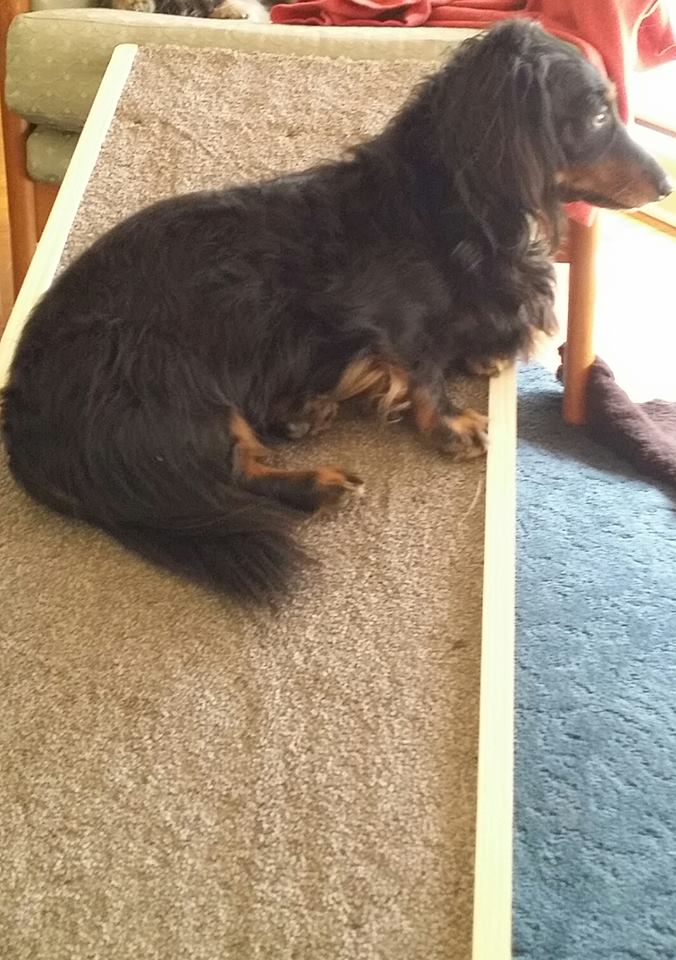Poppy
Our encounter with IVDD started with a Yelp! It was the Friday evening of Mother’s Day weekend 2015. I picked Poppy up to put her in the car and she yelped. Oh no. Saturday morning we were at the vet who confirmed it was her back and gave her pain killers and advised keeping her quiet. But, through the day, she didn’t seem to be getting better, in fact, she got worse and worse. At bedtime I thought “We’ll be back at the vet in the morning”, but hoped she would benefit from some sleep. By 2 am Sunday morning (Mother’s Day) Poppy’s back legs had lost function and she was in clear pain. I knew I had to move fast. I rang the after-hours number for the vet and met him at 3am for a very serious discussion.
Having attended a lecture on IVDD by Dr. Charles Kuntz of Southpaws in February of 2015, I already had an idea of what IVDD was and what could be done to remedy the damage. Also, an idea of what it would cost if surgery were required. But the most important thing I learned was that IVDD is a TREATABLE condition with a very good outcome for the dog. So that really took away my thought that if my dog had it, then that was the end. IVDD became a solvable problem.
So when, in May, my vet suggested surgery, I had made the decision ahead of him and said Yes. By 4am we were at Southpaws Specialty Surgery.
Surgery was Poppy’s only option. Crate rest was not for her as things were too bad. She had no deep pain and, going into surgery, she had a 50% chance of walking again. The surgery went very well and she had deep pain when she woke up, greatly increasing her chances. She came home the next day with a cone on her head, and a catheter at the other end, and a very large piece of sticking plaster in the middle. She was so relieved to see me.
In between I had been busy. Thanks to an excellent friend who had been through IVDD with her dog, I had a crate, some wee pads, a water bowl, some blankets and most of the things I would need to look after Poppy in her crate. We were also given some Rosehip Vital in a lovely care package from the Pay It Forward scheme.
So into the crate she went. It was her safe place, protected from my other dog, but, importantly, still included in the family. I found some wheels to go under it and she was with us in any room. She was brighter the next day, but couldn’t walk at all and needed to be carried out. She could stand on one hind leg but showed no signs of walking, in fact her back legs were bags of skin with bones in them. After 3 days she did a poo! And, after a week, She Wagged Her Tail!! Poppy was on her way.
Poppy could support herself with one back leg after 2 weeks (so the catheter could come out) but it took ages for the other leg to start to function again. We went to hydrotherapy to build up her muscles and this was terrific. The team at Dogs In Motion Canine Rehabilitation were brilliant, carefully staging the sessions so that Poppy could handle the work. We had ‘at home’ exercises to do every day also and began to go for small walks, using the sling to support the back end. Bit by bit she healed and began to improve.
IVDD in your dog is a terrible event to witness, and the more you know about it before onset the better. You need to recognise the symptoms and react quickly in getting experienced veterinary help. Delay makes recovery longer and less certain.
Recovery is all about your Team. Our Team was the Surgeons, the Rehab, the Friends who supplied the crate, the pram to get her out and sniffing, the words of wisdom and kindness (and the chocolate), my Mum and the Community of people of the DISA Facebook page with their stories and experiences and confidence that things would improve. The overwhelming fear at the beginning gave way to the “new normal” routine, which leads to the recovered dog, whatever that recovery is, in whatever time that takes.
Poppy is now walking and running and pain free. She is cheeky and naughty and bright. Her left hind leg functions but is still affected (15 months later) and probably will always be weaker. We now have a ramp and non- slip floor coverings. There are also still small improvements. She can now trot for quite a distance, before breaking into a bunny hopping canter. She is fit and healthy. She barks at everything. Thanks to our Team.
Liz & Poppy

